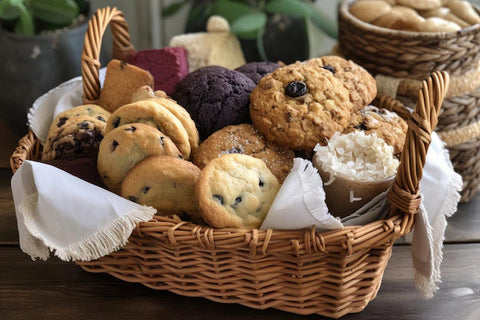Decoding Profit Margins: Most Profitable Baked Goods for Bakeries
If you're stepping into the world of baking as a business, it's essential to know that not all baked goods are created equal – at least not in terms of profitability. Just as in any business, some products offer higher profit margins than others. Recognizing and focusing on these items can significantly enhance your bottom line. In this post, we'll dive deep into the world of baked goods and their profit margins, offering insights to make your bakery venture a sweet success.
Understanding Profit Margins
Before we delve into specifics, let's get a clear understanding of profit margins. Essentially, a profit margin represents the percentage of sales that exceed the cost of producing an item. It's calculated as:
For example, if you sell a cake for $10 and it costs $6 to make, your profit margin would be:
The higher the percentage, the higher the profitability of the product.
Most Profitable Baked Goods
While individual profit margins might vary depending on factors like location, source of ingredients, and overhead costs, here are some baked goods generally considered to be highly profitable:
-
Cookies: With a basic set of ingredients like flour, sugar, eggs, and butter, cookies are relatively inexpensive to produce. They can be sold individually or in larger quantities, and there's always room for premium offerings like organic or gluten-free varieties. Let's say it costs you $0.50 to produce one cookie, and you sell it for $2. That's a profit margin of 75%!
-
Cupcakes: These miniature delights can be sold at a premium, especially when decorated beautifully or infused with unique flavors. If a cupcake costs $1.50 to produce and is sold for $4, you're looking at a profit margin of 62.5%.
-
Bread: While the profit margins on bread might be slightly lower than cookies or cupcakes due to the longer production time and potential for spoilage, artisanal or specialty bread can command higher prices. If you produce a loaf for $2 and sell it for $5, that's a 60% profit margin.
-
Brownies and Bars: These are another category of baked goods that have a generally high profit margin, given their simple ingredients and easy production process. A brownie might cost $1 to make and sell for $3, yielding a profit margin of 66.7%.
-
Pies and Tarts: While they might require more ingredients and preparation than cookies or brownies, pies and tarts can be sold at a premium, especially during holiday seasons. If a pie costs $8 to make and sells for $20, that's a profit margin of 60%.

Factors Influencing Profit Margins
While the above are broad estimates, many factors can influence the profitability of baked goods:
-
Quality of Ingredients: Premium ingredients cost more, but they can also justify higher selling prices.
-
Overhead Costs: Utilities, rent, staff salaries, and other operational costs will affect your profit margins.
-
Local Demand and Competition: If there's high demand for a particular item, or if you're the only bakery offering a specialty product, you might be able to command higher prices.
-
Packaging and Presentation: Beautiful packaging can justify a higher selling price, but remember that it also adds to your costs.
In conclusion, while understanding general trends in profitability is essential, it's crucial to know your costs accurately and keep an eye on local market conditions. By focusing on high-margin products while also catering to your customers' desires, your bakery is bound to rise to success!
Macarons: These delicate French cookies can fetch a high price, especially given their reputation as a gourmet treat. Though they require skill and some specialized ingredients, their selling price is generally high. If one macaron costs $0.75 to produce and sells for $3, the profit margin is about 75%.
-
Cakes: While standard cakes have a good profit margin, custom cakes for events can be particularly profitable. For a basic cake costing $10 to produce and selling for $25, the profit margin is 60%. Custom designs and flavors can substantially increase this.
-
Muffins: Like cupcakes, but generally simpler, muffins can be produced in large batches. If a muffin costs $0.80 to make and sells for $2.50, the profit margin is 68%.
-
Donuts: Donuts, especially specialty or gourmet versions, have gained popularity. Producing a donut might cost $0.70, and if sold for $2.50, the profit margin is 72%.
-
Croissants: Though they require skill due to their laminated dough, they can fetch a good price, especially if they're large or filled. A croissant costing $1 to produce and selling for $3.50 would have a profit margin of 71.4%.
-
Danishes: Similar to croissants but often filled with sweet fillings or fruit. If a Danish costs $1.50 to produce and sells for $4, the margin is 62.5%.
-
Scones: A popular breakfast and teatime treat, scones can be made in various flavors. If one costs $0.90 to produce and sells for $3, the profit margin stands at 70%.
-
Pretzels: Both sweet and savory versions can be sold. A pretzel might cost $1 to produce, but if sold for $3, the profit margin is 66.7%.
-
Biscotti: These twice-baked Italian cookies are long-lasting and can be made in bulk. If producing one costs $0.60 and it sells for $2, the profit margin is 70%.
-
Eclairs & Cream Puffs: These choux pastry treats are filled with cream and can be sold at a premium. An eclair might cost $1.20 to produce but can sell for $3.50, yielding a profit margin of 65.7%.

Remember, these are general estimates, and actual profit margins can vary depending on factors previously mentioned: ingredient quality, overhead costs, local demand, competition, and presentation. The key is to find the sweet spot between quality and cost to ensure your bakery’s offerings are both delicious and profitable!
